现在分词和过去分词的用法
- 格式:doc
- 大小:76.00 KB
- 文档页数:4
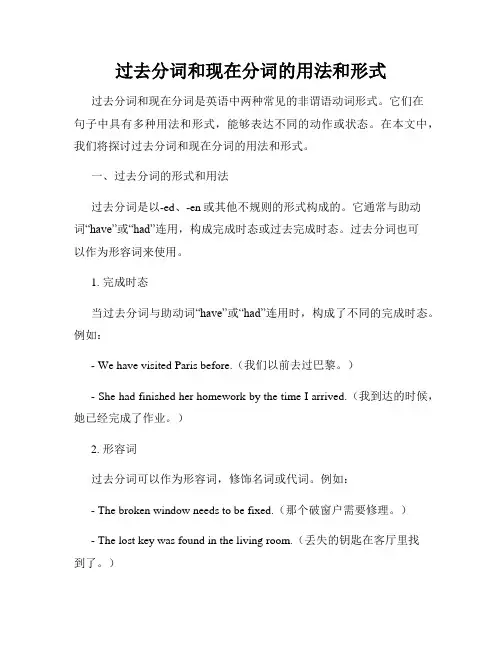
过去分词和现在分词的用法和形式过去分词和现在分词是英语中两种常见的非谓语动词形式。
它们在句子中具有多种用法和形式,能够表达不同的动作或状态。
在本文中,我们将探讨过去分词和现在分词的用法和形式。
一、过去分词的形式和用法过去分词是以-ed、-en或其他不规则的形式构成的。
它通常与助动词“have”或“had”连用,构成完成时态或过去完成时态。
过去分词也可以作为形容词来使用。
1. 完成时态当过去分词与助动词“have”或“had”连用时,构成了不同的完成时态。
例如:- We have visited Paris before.(我们以前去过巴黎。
)- She had finished her homework by the time I arrived.(我到达的时候,她已经完成了作业。
)2. 形容词过去分词可以作为形容词,修饰名词或代词。
例如:- The broken window needs to be fixed.(那个破窗户需要修理。
)- The lost key was found in the living room.(丢失的钥匙在客厅里找到了。
)二、现在分词的形式和用法现在分词是以-ing结尾的动词形式,常用于进行时态,或作为形容词和副词来使用。
1. 进行时态现在分词与“be”动词连用,构成了进行时态,表示正在进行的动作或状态。
例如:- He is studying for the exam.(他正在为考试复习。
)- They were playing basketball in the park.(他们在公园里打篮球。
)2. 形容词现在分词可以作为形容词,修饰名词或代词。
例如:- The running water is very clear.(流动的水非常清澈。
)- I saw a crying baby on the street.(我在街上看到一个哭泣的婴儿。
)3. 副词现在分词还可以作为副词,修饰动词或整个句子。
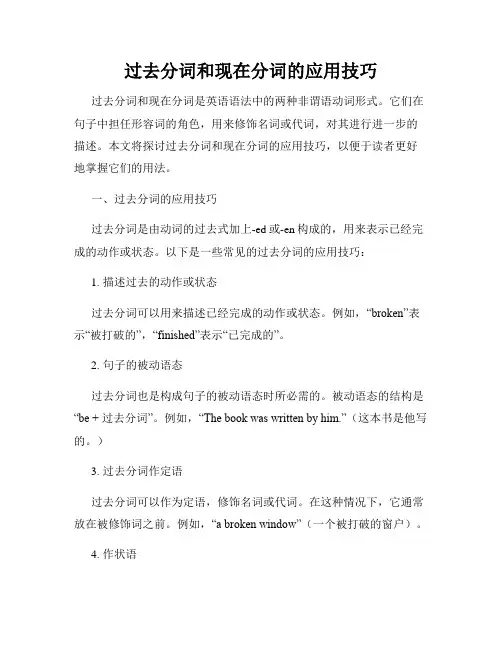
过去分词和现在分词的应用技巧过去分词和现在分词是英语语法中的两种非谓语动词形式。
它们在句子中担任形容词的角色,用来修饰名词或代词,对其进行进一步的描述。
本文将探讨过去分词和现在分词的应用技巧,以便于读者更好地掌握它们的用法。
一、过去分词的应用技巧过去分词是由动词的过去式加上-ed或-en构成的,用来表示已经完成的动作或状态。
以下是一些常见的过去分词的应用技巧:1. 描述过去的动作或状态过去分词可以用来描述已经完成的动作或状态。
例如,“broken”表示“被打破的”,“finished”表示“已完成的”。
2. 句子的被动语态过去分词也是构成句子的被动语态时所必需的。
被动语态的结构是“be + 过去分词”。
例如,“The book was written by him.”(这本书是他写的。
)3. 过去分词作定语过去分词可以作为定语,修饰名词或代词。
在这种情况下,它通常放在被修饰词之前。
例如,“a broken window”(一个被打破的窗户)。
4. 作状语过去分词可以作为状语,表示原因、条件、时间、方式等。
例如,“Having finished my work, I went home.”(完成了我的工作,我回家了。
)二、现在分词的应用技巧现在分词是由动词的原形加上-ing构成的,表示正在进行或持续的动作或状态。
以下是一些常见的现在分词的应用技巧:1. 描述正在进行的动作或状态现在分词可以用来描述当前正在进行的动作或状态。
例如,“running”表示“正在跑步的”,“reading”表示“正在阅读的”。
2. 句子的进行时态现在分词是构成句子的进行时态时所必需的。
进行时态的结构是“be + 现在分词”。
例如,“He is studying English.”(他正在学习英语。
)3. 现在分词作定语现在分词可以作为定语,修饰名词或代词。
在这种情况下,它通常放在被修饰词之前。
例如,“a running river”(一条正在流动的河流)。
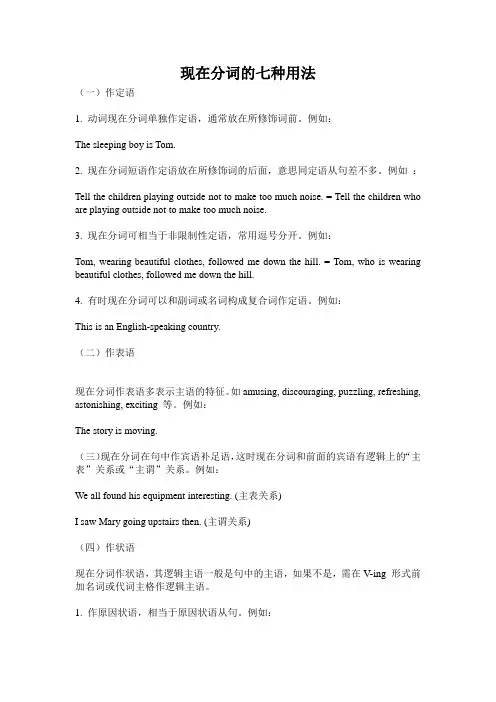
现在分词的七种用法(一)作定语1. 动词现在分词单独作定语,通常放在所修饰词前。
例如:The sleeping boy is Tom.2. 现在分词短语作定语放在所修饰词的后面,意思同定语从句差不多。
例如:Tell the children playing outside not to make too much noise. = Tell the children who are playing outside not to make too much noise.3. 现在分词可相当于非限制性定语,常用逗号分开。
例如:Tom, wearing beautiful clothes, followed me down the hill. = Tom, who is wearing beautiful clothes, followed me down the hill.4. 有时现在分词可以和副词或名词构成复合词作定语。
例如:This is an English-speaking country.(二)作表语现在分词作表语多表示主语的特征。
如amusing, discouraging, puzzling, refreshing, astonishing, exciting 等。
例如:The story is moving.(三)现在分词在句中作宾语补足语,这时现在分词和前面的宾语有逻辑上的“主表”关系或“主谓”关系。
例如:We all found his equipment interesting. (主表关系)I saw Mary going upstairs then. (主谓关系)(四)作状语现在分词作状语,其逻辑主语一般是句中的主语,如果不是,需在V-ing 形式前加名词或代词主格作逻辑主语。
1. 作原因状语,相当于原因状语从句。
例如:Being ill, Mary didn't come to school yesterday.2. 作时间状语,相当于时间状语从句。
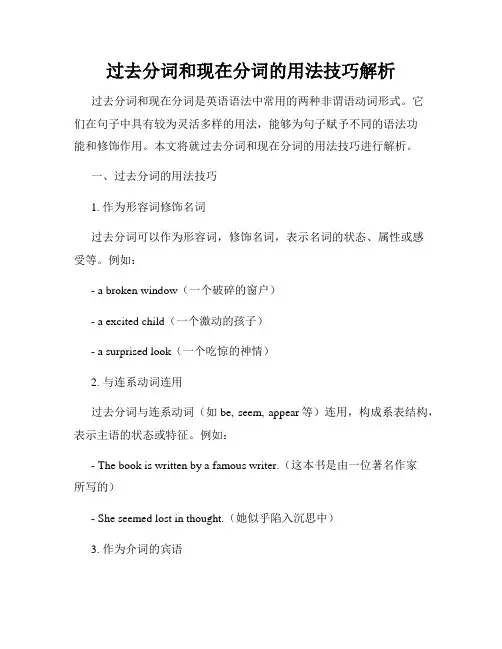
过去分词和现在分词的用法技巧解析过去分词和现在分词是英语语法中常用的两种非谓语动词形式。
它们在句子中具有较为灵活多样的用法,能够为句子赋予不同的语法功能和修饰作用。
本文将就过去分词和现在分词的用法技巧进行解析。
一、过去分词的用法技巧1. 作为形容词修饰名词过去分词可以作为形容词,修饰名词,表示名词的状态、属性或感受等。
例如:- a broken window(一个破碎的窗户)- a excited child(一个激动的孩子)- a surprised look(一个吃惊的神情)2. 与连系动词连用过去分词与连系动词(如be, seem, appear等)连用,构成系表结构,表示主语的状态或特征。
例如:- The book is written by a famous writer.(这本书是由一位著名作家所写的)- She seemed lost in thought.(她似乎陷入沉思中)3. 作为介词的宾语过去分词可以作为介词的宾语,表示动作的被动、完成或结果。
例如:- He is proud of having won the competition.(他为自己赢得了比赛而感到骄傲)- I am tired of being treated unfairly.(我厌倦了受到不公平对待)4. 与情态动词连用过去分词与情态动词(如can, could, may, might等)连用,表示对过去某一动作或状态的推测或假设。
例如:- He may have finished his homework.(他可能已经完成了作业)- She could have missed the train.(她可能错过了火车)二、现在分词的用法技巧1. 作为形容词修饰名词现在分词可以作为形容词,修饰名词,表示名词的特点、特征或状态等。
例如:- a running river(一条流动的河流)- a smiling face(一个微笑的脸)2. 作为主动语态的非谓语动词现在分词可以独立担任主语、宾语或表语等成分,表示某个正在进行的动作或状态。
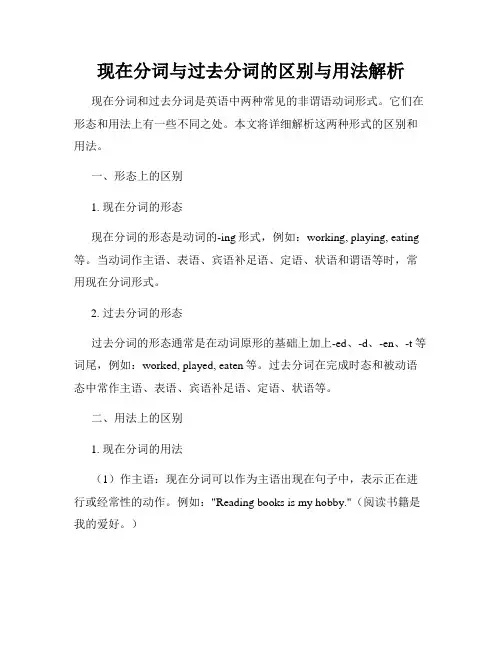
现在分词与过去分词的区别与用法解析现在分词和过去分词是英语中两种常见的非谓语动词形式。
它们在形态和用法上有一些不同之处。
本文将详细解析这两种形式的区别和用法。
一、形态上的区别1. 现在分词的形态现在分词的形态是动词的-ing形式,例如:working, playing, eating 等。
当动词作主语、表语、宾语补足语、定语、状语和谓语等时,常用现在分词形式。
2. 过去分词的形态过去分词的形态通常是在动词原形的基础上加上-ed、-d、-en、-t等词尾,例如:worked, played, eaten等。
过去分词在完成时态和被动语态中常作主语、表语、宾语补足语、定语、状语等。
二、用法上的区别1. 现在分词的用法(1)作主语:现在分词可以作为主语出现在句子中,表示正在进行或经常性的动作。
例如:"Reading books is my hobby."(阅读书籍是我的爱好。
)(2)作定语:现在分词可以修饰名词作定语,常表示主动、进行或经常性的动作。
例如:"The running water is very clear."(流动的水非常清澈。
)(3)作宾语补足语:现在分词可以作及物动词的宾语补足语,表示正在进行或经常性的动作。
例如:"I saw him painting the house."(我看见他正在刷房子。
)2. 过去分词的用法(1)作主语:过去分词可以作为主语出现在句子中,表示完成的动作或状态。
例如:"Broken glass covered the ground."(破碎的玻璃铺满了地面。
)(2)作定语:过去分词可以修饰名词作定语,表示被动或完成的动作。
例如:"The lost key has been found."(丢失的钥匙已经找到了。
)(3)作宾语补足语:过去分词可以作及物动词的宾语补足语,表示完成的动作或状态。

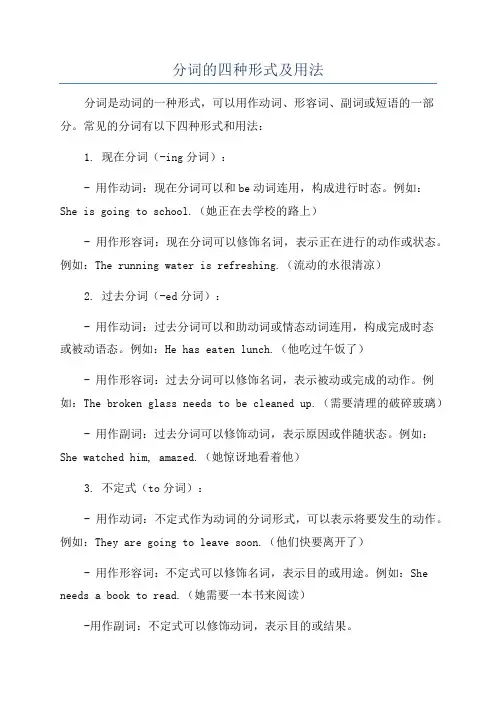
分词的四种形式及用法分词是动词的一种形式,可以用作动词、形容词、副词或短语的一部分。
常见的分词有以下四种形式和用法:1. 现在分词(-ing分词):- 用作动词:现在分词可以和be动词连用,构成进行时态。
例如:She is going to school.(她正在去学校的路上)- 用作形容词:现在分词可以修饰名词,表示正在进行的动作或状态。
例如:The running water is refreshing.(流动的水很清凉)2. 过去分词(-ed分词):- 用作动词:过去分词可以和助动词或情态动词连用,构成完成时态或被动语态。
例如:He has eaten lunch.(他吃过午饭了)- 用作形容词:过去分词可以修饰名词,表示被动或完成的动作。
例如:The broken glass needs to be cleaned up.(需要清理的破碎玻璃)- 用作副词:过去分词可以修饰动词,表示原因或伴随状态。
例如:She watched him, amazed.(她惊讶地看着他)3. 不定式(to分词):- 用作动词:不定式作为动词的分词形式,可以表示将要发生的动作。
例如:They are going to leave soon.(他们快要离开了)- 用作形容词:不定式可以修饰名词,表示目的或用途。
例如:She needs a book to read.(她需要一本书来阅读)-用作副词:不定式可以修饰动词,表示目的或结果。
4.分词短语:- 用作动词:分词短语作为动词的一部分,可以表示时间、原因、条件等。
例如:Hearing the news, she cried.(听到消息,她哭了)- 用作形容词:分词短语可以修饰名词,表示状态或特征。
例如:The students studying in the library are quiet.(在图书馆学习的学生都很安静)-用作副词:分词短语可以修饰动词,表示方式或条件。
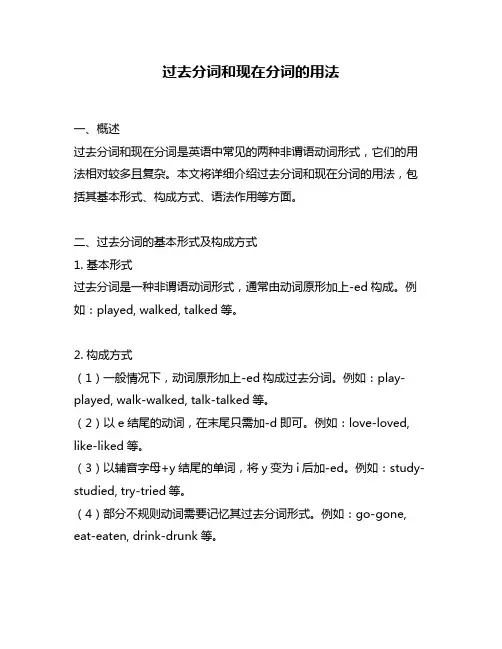
过去分词和现在分词的用法一、概述过去分词和现在分词是英语中常见的两种非谓语动词形式,它们的用法相对较多且复杂。
本文将详细介绍过去分词和现在分词的用法,包括其基本形式、构成方式、语法作用等方面。
二、过去分词的基本形式及构成方式1. 基本形式过去分词是一种非谓语动词形式,通常由动词原形加上-ed构成。
例如:played, walked, talked等。
2. 构成方式(1)一般情况下,动词原形加上-ed构成过去分词。
例如:play-played, walk-walked, talk-talked等。
(2)以e结尾的动词,在末尾只需加-d即可。
例如:love-loved, like-liked等。
(3)以辅音字母+y结尾的单词,将y变为i后加-ed。
例如:study-studied, try-tried等。
(4)部分不规则动词需要记忆其过去分词形式。
例如:go-gone, eat-eaten, drink-drunk等。
三、过去分词的用法1. 作定语过去分词可以作为定语修饰名词或代词,表示被修饰物所受到的动作或状态。
例如:a broken cup(一个破碎的杯子)、a tired man(一个疲惫的人)等。
2. 作表语过去分词可以作为表语,表示主语所处的状态或被动动作。
例如:The door is closed.(门已经关上了。
)3. 作宾补过去分词可以作为及物动词的宾语补足语,表示被动动作或状态。
例如:I saw him beaten up by the gangsters.(我看到他被黑帮殴打了。
)4. 与情态动词连用过去分词可以与情态动词连用,表示完成的被动意义。
例如:He should have been told the truth.(他应该被告知真相。
)5. 与助动词连用过去分词可以与助动词have, has, had连用,构成完成时态和完成进行时态,表示已经发生的事情或正在进行的事情已经完成。
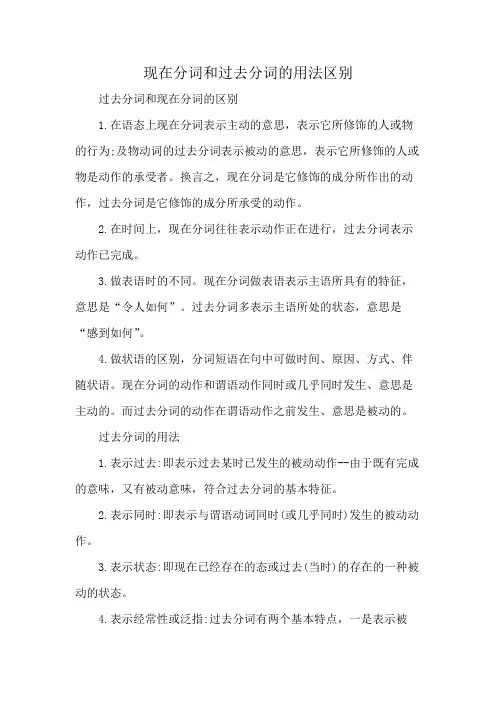
现在分词和过去分词的用法区别
过去分词和现在分词的区别
1.在语态上现在分词表示主动的意思,表示它所修饰的人或物的行为;及物动词的过去分词表示被动的意思,表示它所修饰的人或物是动作的承受者。
换言之,现在分词是它修饰的成分所作出的动作,过去分词是它修饰的成分所承受的动作。
2.在时间上,现在分词往往表示动作正在进行,过去分词表示动作已完成。
3.做表语时的不同。
现在分词做表语表示主语所具有的特征,意思是“令人如何”。
过去分词多表示主语所处的状态,意思是“感到如何”。
4.做状语的区别,分词短语在句中可做时间、原因、方式、伴随状语。
现在分词的动作和谓语动作同时或几乎同时发生、意思是主动的。
而过去分词的动作在谓语动作之前发生、意思是被动的。
过去分词的用法
1.表示过去:即表示过去某时已发生的被动动作--由于既有完成的意味,又有被动意味,符合过去分词的基本特征。
2.表示同时:即表示与谓语动词同时(或几乎同时)发生的被动动作。
3.表示状态:即现在已经存在的态或过去(当时)的存在的一种被动的状态。
4.表示经常性或泛指:过去分词有两个基本特点,一是表示被
动,二是表示完成。
现在分词的用法
1.现在分词的一般式所表示的动作与主语动作同时发生。
2.当要表示一个被动动作时,现在分词就用被动形式。
3.分词的否定式总是将否定词not置于分词之前,遇上现在分词的完成式、被动式以及完成被动式,否定词应置于整个结构之前。
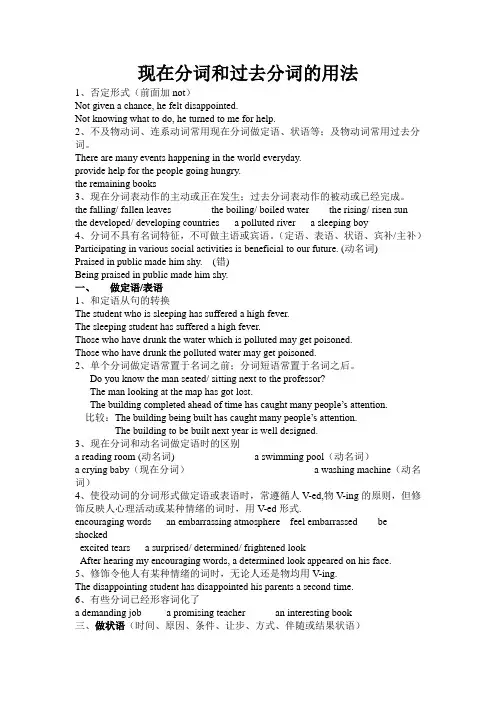
现在分词和过去分词的用法1、否定形式(前面加not)Not given a chance, he felt disappointed.Not knowing what to do, he turned to me for help.2、不及物动词、连系动词常用现在分词做定语、状语等;及物动词常用过去分词。
There are many events happening in the world everyday.provide help for the people going hungry.the remaining books3、现在分词表动作的主动或正在发生;过去分词表动作的被动或已经完成。
the falling/ fallen leaves the boiling/ boiled water the rising/ risen sun the developed/ developing countries a polluted river a sleeping boy4、分词不具有名词特征,不可做主语或宾语。
(定语、表语、状语、宾补/主补)Participating in various social activities is beneficial to our future. (动名词)Praised in public made him shy. (错)Being praised in public made him shy.一、做定语/表语1、和定语从句的转换The student who is sleeping has suffered a high fever.The sleeping student has suffered a high fever.Those who have drunk the water which is polluted may get poisoned.Those who have drunk the polluted water may get poisoned.2、单个分词做定语常置于名词之前;分词短语常置于名词之后。
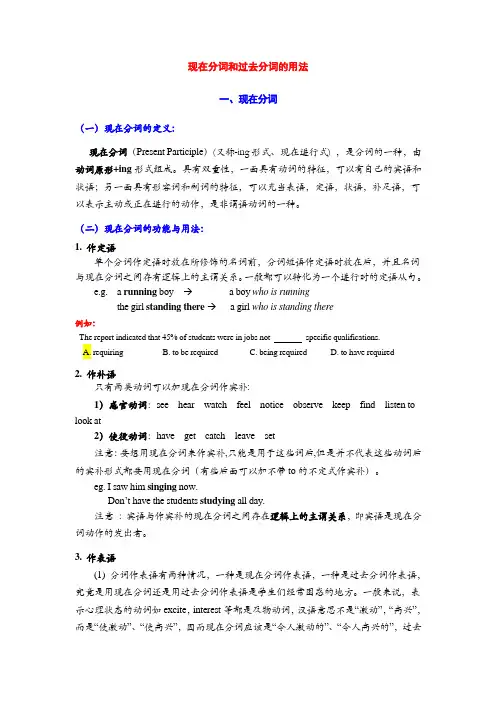
现在分词和过去分词的用法一、现在分词(一)现在分词的定义:现在分词(Present Participle)(又称-ing形式、现在进行式) ,是分词的一种,由动词原形+ing形式组成。
具有双重性,一面具有动词的特征,可以有自己的宾语和状语;另一面具有形容词和副词的特征,可以充当表语,定语,状语,补足语,可以表示主动或正在进行的动作,是非谓语动词的一种。
(二)现在分词的功能与用法:1. 作定语单个分词作定语时放在所修饰的名词前,分词短语作定语时放在后,并且名词与现在分词之间存有逻辑上的主谓关系。
一般都可以转化为一个进行时的定语从句。
e.g. a running boy→ a boy who is runningthe girl standing there → a girl who is standing there例如:The report indicated that 45% of students were in jobs not specific qualifications.A. requiringB. to be requiredC. being requiredD. to have required2. 作补语只有两类动词可以加现在分词作宾补:1)感官动词:see hear watch feel notice observe keep find listen tolook at2)使役动词:have get catch leave set注意:要想用现在分词来作宾补,只能是用于这些词后,但是并不代表这些动词后的宾补形式都要用现在分词(有些后面可以加不带to的不定式作宾补)。
eg. I saw him singing now.Don’t have the students studying all day.注意:宾语与作宾补的现在分词之间存在逻辑上的主谓关系,即宾语是现在分词动作的发出者。
过去分词与现在分词用法比较英语中的分词分两种:现在分词(the present participle)和过去分词(the past participle)。
虽然它们在句子中都可作名词修饰语、接系动词补足语、宾语补足语等,但是它们形式不同,而且语义也有差别。
现在从四方面举例说明。
⒈现在分词表示动作是主动的和正在实行的(例①-③);过去分词的动作是被动的和完成的(例④-⑥):① The boiling water is hot.② A sleep ing baby is good to look at.③ She has a smiling face.④ You can use the boiled water to make tea.⑤ Where is my lost key?⑥ A broken mirror cannot be repaired.有时,因为两个动词“异词同义”,其分词也跟着不同,如:⑦a. Have you seen the man wearing a T-shirt?b. Who is the man dressed in a blue shirt?⑧a. His new book consisting of useful data has been well received.b. Do you like the book made up of untrue stories?⒉在语义上,现在分词和过去分词反映的心理状态不同。
前者有“令人……”的含义(见例⑨);过去分词则有“感到……”的意思(见例⑩):⑨ The soccer ma tch last night was thrilling.(令人紧张)⑩ The soccer fans were delighted.(感到快乐)其他例子有:● amazing: amazed;● annoying: annoyed;● boring: bored;● confusing: confused;● surprising: surprised;● terrifying: terrified试比较11a和b以及12a和b:11a. This is the most confusing system I have ever seen.11b. The children will get confused if asked to learn too much at a time.12a. David came with some surprising news.12b. All were surprised at Sam's sudden resignation.⒊在作宾语补足语时,假如宾语是相关分词逻辑上的主语,就用现在分词,如:13. The teacher found a student dozing off.14. Don't keep the visitor waiting.假如宾语和相关分词有“动词+宾语”关系,那么这个分词就要是过去分词了,如:15. Where did you get your book printed?16. You should have your office whitewashed.在13里,正在打瞌睡的是宾语“a student”; 在14里,宾语是“the visitor”。
过去分词和现在分词的用法1. 什么是过去分词和现在分词?过去分词和现在分词是英语中的两种非谓语动词形式,它们分别以-ing和-ed结尾。
过去分词和现在分词在句子中可以起到多种用途,包括作为形容词、动词、副词和名词的补语等。
2. 过去分词的用法2.1 作为形容词过去分词可以用来描述过去发生的动作或状态,并修饰名词。
例如: - The broken window needs to be fixed.(被打破的窗户需要修理。
)- She was excited to receive a handwritten letter.(她收到一封亲笔信感到很兴奋。
)2.2 作为动词过去分词可以和助动词have、has、had结合,构成完成时态的谓语动词。
例如: - I have finished my homework.(我完成了我的作业。
) - They had already eaten before I arrived.(当我到达时,他们已经吃饭了。
)2.3 作为副词过去分词可以修饰一个动作的方式或者程度,并回答“怎么样?”“多么?”等问题。
例如: - He ran excitedly towards the finish line.(他兴奋地跑向终点线。
)- The movie was surprisingly interesting.(这部电影出人意料地有趣。
)2.4 作为名词的补语过去分词可以用来补充或者说明名词所表示的主语。
例如: - I am a teacher by profession.(我是一个职业教师。
) - She felt embarrassed by his behavior.(她因他的行为感到尴尬。
)3. 现在分词的用法3.1 作为形容词现在分词可以用来描述正在进行的动作或状态,并修饰名词。
例如: - The running water is so refreshing.(流动的水非常清爽。
现在分词和过去分词的用法现在分词和过去分词主要差别在于:现在分词表示“主动和进行”,过去分词表示“被动和完成”(不及物动词的过去分词不表示被动,只表示完成)。
分词可以有自己的状语、宾语或逻辑主语等。
表示伴随 1. 分词作状语分词在句子中作状语,可以表示时间、条件、原因现在分词和过去分词主要差别在于:现在分词表示“主动和进行”,过去分词表示“被动和完成”(不及物动词的过去分词不表示被动,只表示完成)。
分词可以有自己的状语、宾语或逻辑主语等。
表示伴随1. 分词作状语分词在句子中作状语,可以表示时间、条件、原因、结果(补充说明)、让步、伴随等。
分词做状语时,它的逻辑主语与句子的主语一致。
作状语的分词相当于一个状语从句。
补充说明补充说明【例】Hearing the news, they all jumped with joy.Using what you know of word stems and word formations, you can make a guess at the meaning of a new word.The students went out of the classroom, laughing and talking.Accompanied by his friend, he went to the railway station. Given better attention, the plants could grow better.He looked tired and depressed, visibly disturbed by the news of his mother's illness.分词在句子中作状语,使用何种分词,要取决于分词与句子主语的关系:主谓关系用现在分词,动宾或被动关系用过去分词。
【例】Not shavings enough hands, we turned to them for help.(we don't have enough hands) Taught by mistakes and setbacks, we have become wiser and handled our affairs better. (we are taught/teach us)Inspired by Leifeng, the people in China worked very hard to achieve their modernization.____the earth to be flat, many feared that Columbus would fall off the edge. (CET-4 1996,6)A) Having believed B) Believing C) Believed D) Being believed本句意思为:相信地球是平的,许多人担心哥伦布会从边上掉下去。
现在分词和过去分词的用法一、现在分词(一)现在分词的定义:现在分词(Present Participle)(又称-ing形式、现在进行式) ,是分词的一种,由动词原形+ing形式组成。
具有双重性,一面具有动词的特征,可以有自己的宾语和状语;另一面具有形容词和副词的特征,可以充当表语,定语,状语,补足语,可以表示主动或正在进行的动作,是非谓语动词的一种。
(二)现在分词的功能与用法:1. 作定语单个分词作定语时放在所修饰的名词前,分词短语作定语时放在后,并且名词与现在分词之间存有逻辑上的主谓关系。
一般都可以转化为一个进行时的定语从句。
e.g. a running boy→ a boy who is runningthe girl standing there → a girl who is standing there例如:The report indicated that 45% of students were in jobs not specific qualifications.A. requiringB. to be requiredC. being requiredD. to have required2. 作补语只有两类动词可以加现在分词作宾补:1)感官动词:see hear watch feel notice observe keep find listen to look at2)使役动词:have get catch leave set注意:要想用现在分词来作宾补,只能是用于这些词后,但是并不代表这些动词后的宾补形式都要用现在分词(有些后面可以加不带to的不定式作宾补)。
eg. I saw him singing now.Don’t have the students studying all day.注意:宾语与作宾补的现在分词之间存在逻辑上的主谓关系,即宾语是现在分词动作的发出者。
动词的现在分词与过去分词的区别动词是语言中的重要组成部分,它们用于表达动作、状态和行为。
动词的现在分词和过去分词是动词的两种非谓语形式。
在英语语法中,它们有着不同的用法和构成。
一、现在分词的构成与用法现在分词是由动词的原形加上-ing构成的,例如:play(玩)→ playing(正在玩)。
现在分词可以用作动词、形容词和副词。
1. 作为动词:现在分词可以作为谓语动词,表示动作正在进行或正在进行的状态。
例:She is reading a book.(她正在看书。
)The birds are singing.(鸟儿在唱歌。
)2. 作为形容词:现在分词可以修饰名词或代词,表示该名词或代词所具有的特征或状态。
例:The running water sounds so soothing.(流动的水声音如此舒缓。
)The crying baby needs to be comforted.(哭泣的婴儿需要安慰。
)3. 作为副词:现在分词可以修饰动词或整个句子,表示附加的动作或方式。
例:He came running to catch the bus.(他跑着过来赶公交车。
)Considering the circumstances, I think we made the right decision.(考虑到情况,我认为我们做出了正确的决定。
)二、过去分词的构成与用法过去分词是由动词的原形加上-ed、-d、-t、-en或常见的不规则变化形式构成的,例如:play(玩)→ played(玩过了)。
过去分词可以用作动词、形容词和副词。
1. 作为动词:过去分词可以表示过去的动作或状态,常与助动词have或be连用,构成完成时态或被动语态。
例:They have finished their homework.(他们完成了作业。
)The house was built in 1990.(房屋建于1990年。
)2. 作为形容词:过去分词可以修饰名词或代词,表示由该名词或代词引起的动作或状态。
现在分词和过去分词的用法区别现在分词和过去分词都是英语中非常重要的语法形式,它们与动词密切相关,但在语法和用法上有其独特之处。
在本文中,我们将学习这两种分词的基本含义、语法用法以及相应的例子,以帮助大家更好地掌握这两种分词的用法区别。
1. 动态用法现在分词主要在动态用法中使用,表示正在进行或正在发生的动作(或状态)。
它通常表示主语正在进行的动作,也可以表示与主语有关的事情(例如,使动词、感觉动词和心理动词)。
以下是现在分词的动态用法的一些例子:- I'm taking a shower (我正在洗澡)。
- She's teaching her dog some tricks (她正在教她的狗一些技巧)。
- The music is playing loudly (音乐正在高声播放)。
- He's feeling sick today (他今天感觉不舒服)。
2. 形容词用法除了动态用法外,现在分词还可以用于形容词用法,形容词用法时表示主语的性质或特征。
这种用法通常用来描述对象或事物,并且可以被用作宾语或主语后的修饰语。
以下是现在分词的形容词用法的一些例子:4. 结构用法现在分词还可以用于结构用法,结构用法时通常用于现在分词和将来进行时或现在进行时一起使用,以强调某个动作或事件的重要性或长时间持续。
以下是现在分词的结构用法的一些例子:1. 过去的被动语态和完成时态过去分词主要用于过去的被动语态和完成时态。
它通常与 be 动词或 have 动词一起出现,以表示动词的被动或完成形式。
以下是过去分词的被动语态和完成时态的一些例子:可以看到,过去分词被用于描述过去的事情,例如完成的动作或被动的状态。
过去分词也可以用于形容词用法,表示受动作影响的人或物的性质或特征。
如过去分词可以形容被破坏的建筑物、被教育的学生等等。
以下是过去分词形容词用法的一些例子:3. 补语用法过去分词还可以用作补语,它是某些及物动词的现在分词形式,并在表达被动语态时使用,通常作为系动词 be 的补语。
现在分词和过去分词的用法一.现在分词和过去分词的构成
done
现在分词完成式所表示的动作发生在谓语动词所表示的动作之前,常用作状语,表时间和原因。
注意现在分词的完成式不能充当定语。
Having noted down our names and addresses , the policeman dismissed us.
表时间,相当于After the policeman noted down our names and addresses , he dismissed us.
I was unable to accept your invitation, having promised to accompany my mother to the concert.
表原因,相当于Because I had promised to accompany my mother to the concert , I was unable to accept your invitation.
Having suffered from heart trouble for many years, Mr. Li has to take medicine wherever he goes .
表原因,注意分词结构带有的时间状语for many years, 时间状语提示分词该采用完成式。
四.现在分词的的被动式
现在分词的一般式和完成式都有被动形式。
The house being built is a big project.
现在分词一般式的被动式,用作定语,表“正在被…”
Being surrounded , the enemy troops were forced to surrender.
现在分词一般式的被动式,表原因。
Did you see the boy being questioned by the police?
Having been told many times, he made the same mistake again and again.
现在分词完成式的被动,表示让步。
五.现在分词的否定式
现在分词的否定式构成是“在带ing的那个词前加not ”。
如
doing --- not doing ; being done --- not being done ;
having been done --- not having been done ; having done---not having done 。
Not having heard from his girlfriend for a long time , he felt very worried.
Not seeing John , I asked where he was.
句型转换
A. 把下列各句改成分词作结构。
1.When it is seen from the hill , the park looks very beautiful.
________________________________________________________________________
2. Don’t speak until you are spoken to.
________________________________________________________________________
3. Because the boy was greatly touched by his teacher’s words, he did a lot of things to help his classmates.
_________________________________________________________________________
4. As he was surprised at what happened, T om didn’t know what to do.
__________________________________________________________________________
5. The meeting, which was attended by over five thousand people, welcomed the great hero.
___________________________________________________________________________ 6. Do you know the man who is speaking our headmaster?
___________________________________________________________________________
B. 把下列各句改成从句形式。
1. Linda worked for the Minnesota Manufacturing and Mining Company, known as 3M.
___________________________________________________________________________ 2. The disc, digitally recorded in the studio, sounded fantastic at the party that night.
_____________________________________________________________________________ 3. The flowers smelling sweet in the botanic garden attract the visitors to the beauty of nature.
_____________________________________________________________________________ 4. Hunted everywhere, the wolves had no where to hide themselves.
______________________________________________________________________________ 5. United , we stand ; divided , we fall.
______________________________________________________________________________ 6. Although exhausted by the climb, he continued his journey.
______________________________________________________________________________ 7. Weather permitting , we’ll have the match tomorrow.
______________________________________________________________________________ 8. Some of them , born and brought up I rural villages, had never seen a train.
_______________________________________________________________________________ 9. Everything goes well as expected.
_______________________________________________________________________________ 10. He fell off the horse as if hit by a bullet.
_______________________________________________________________________________。